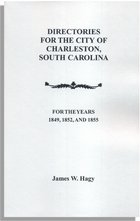
|
|
|
| Product Information: | ||
| Details: | Directories for the City of Charleston, South Carolina for the Years 1849, 1852, and 1855; by James W. Hagy; 176 pp; Paperback; Published: 1998; ISBN: 9780806348223; Item # CF9338D This is the fifth volume in Mr. Hagy's series of transcriptions of city directories for the ante bellum population of Charleston, South Carolina (see also Items 9134, 9135, 9185, 9187, and 9405). Directories for the City of Charleston, South Carolina for the Years 1849, 1852, and 1855 picks up where the fourth volume in the series, which spanned the period 1830-1841, left off. For this new book the author has compiled all the names and other pertinent genealogical information that can be found in the Charleston city directories of 1849, 1852, and 1855. The names of the residents in each of the three directories are arranged in alphabetical order, and each entry, typically, furnishes the individual's address and his occupation (or, in the case of female heads of household, whether the individual is widowed). Unlike earlier volumes in this series, these directories lack separate sections listing Charleston's Free Persons of Color--a fact no doubt attributable to the rising racial tensions that gripped South Carolina prior to the Civil War. The three directories combined furnish the names and addresses of more than 16,000 Charlestonians. Since an individual name and/or address may appear and/or disappear from one directory to the next, Mr. Hagy's new directory, like its predecessors, affords genealogists the rare opportunity of tracing the mobility or migration of a given ancestor at very close range. In addition to the residents themselves, the volume points up a number of interesting features relating to the city of Charleston at this time, such as the annexation of new sections of the city, the appearance of photographers (daguerreotypists) among the business community, the growing importance of advertisements and the separate business directory appended to the back of each directory, and so on. It should be pointed out that Mr. Hagy has retained the references to public buildings, churches, public amusements, literary institutions, public schools, justices and notaries, lodges, and more, which were not strictly a part of the population listings. Also included is biographical information on the publishers of the various directories. |
|

